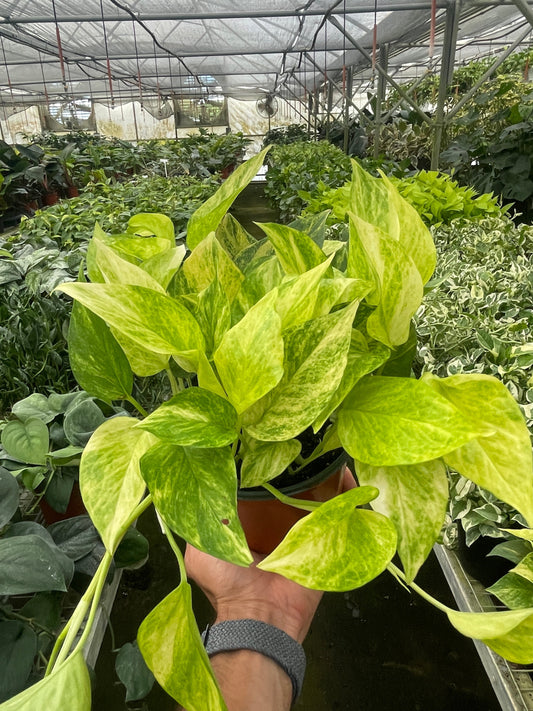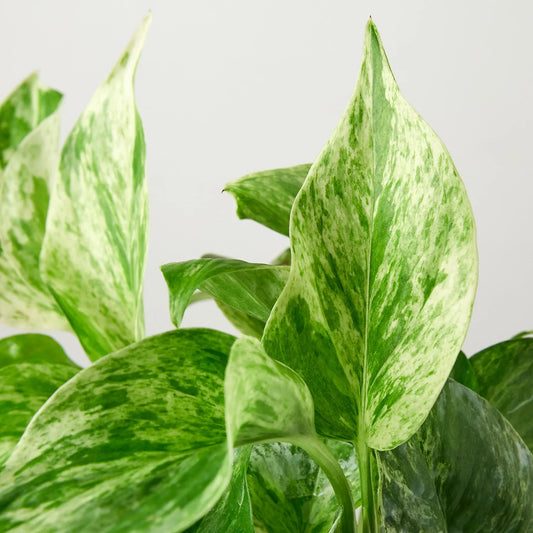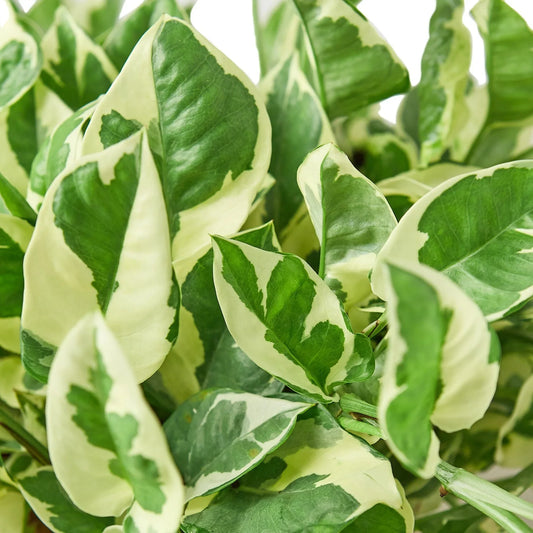Do Satin Pothos Bloom? A Guide to Satin Pothos Flowers
Cafe Planta Team
Houseplants have a special way of adding life to our homes, and Satin Pothos (Scindapsus pictus) is no exception. Known for its striking, silvery leaves and easy-care nature, this plant is a favorite among many plant parents. But, have you ever wondered if these beauties bloom? Let's explore the world of Satin Pothos and uncover the mystery behind its flowering habits.
In this article, we'll dig into whether Satin Pothos can produce flowers and what those flowers might look like. We'll also touch on how to care for your Satin Pothos to ensure it thrives, even if it never blooms. Whether you're a seasoned plant lover or new to the game, there's something here for everyone.
Understanding Satin Pothos: The Basics
Satin Pothos, with its elegant and velvety leaves, is a popular choice for those looking to add a touch of greenery to their spaces. This plant is native to Southeast Asia and is often confused with its relative, the Golden Pothos (Epipremnum aureum). However, Satin Pothos stands out with its distinctive foliage, which features a matte finish and silvery spots that can reflect light beautifully.
One reason many people love Satin Pothos is its adaptability. It can thrive in various lighting conditions, from bright, indirect light to low-light environments, making it perfect for almost any room in your home. Additionally, it's a low-maintenance plant, requiring only occasional watering and minimal pruning to keep it looking its best. But when it comes to blooming, things get a bit more intriguing.
Do Satin Pothos Bloom?
The short answer is yes, but not in the way you might expect. In their natural habitat, Satin Pothos can produce flowers. However, these blooms are quite rare in indoor settings. The plant is primarily grown for its foliage, and under typical houseplant conditions, flowering is uncommon.
When Satin Pothos does bloom, the flowers are not particularly showy or fragrant. They appear as small, greenish structures similar to those of peace lilies or anthuriums, which makes sense given they're all part of the Araceae family. If you're hoping for a floral spectacle, you might be disappointed. However, the unique beauty of Satin Pothos lies in its leaves, which are captivating all on their own.
Why Satin Pothos Rarely Blooms Indoors
Several factors contribute to the rarity of Satin Pothos blooms indoors. The primary reason is that the plant's natural environment, which includes high humidity, consistent warmth, and specific light conditions, is difficult to replicate inside our homes. Here are a few reasons why you might not see flowers on your Satin Pothos:
- Light Conditions: Satin Pothos thrives in indirect light, but flowering requires more intense light, which can be hard to achieve indoors without risking leaf burn.
- Humidity Levels: In its native habitat, Satin Pothos enjoys high humidity, something that our homes, especially during winter months, often lack.
- Age of the Plant: Younger plants are less likely to bloom. It often takes several years for a plant to mature enough to produce flowers.
While it's challenging to create the perfect conditions for flowering, the good news is that your Satin Pothos will remain a stunning addition to your home even without blooms.
Caring for Your Satin Pothos
Despite the rarity of flowers, keeping a Satin Pothos happy is relatively straightforward. Here are some tips to ensure your plant thrives:
- Lighting: Provide bright, indirect light. Too much direct sunlight can scorch the leaves, while too little light can slow growth.
- Watering: Allow the top inch of soil to dry out between waterings. Overwatering can lead to root rot, a common issue for many houseplants.
- Humidity: While not mandatory, increased humidity can benefit your plant. Consider using a pebble tray or a humidifier if your home is particularly dry.
- Fertilization: Feed your Satin Pothos with a balanced, water-soluble fertilizer every few months during the growing season (spring and summer).
Pruning and Propagation Tips
Pruning your Satin Pothos isn't just about aesthetics; it can also encourage healthier growth. Here's how to keep your plant in top shape:
- Pruning: Trim back any leggy growth or damaged leaves to maintain a bushy appearance. Use clean, sharp scissors or pruning shears to prevent disease.
- Propagation: Satin Pothos is easy to propagate. Simply cut a stem with a few nodes and place it in water or soil. Within a few weeks, you'll see new roots forming.
Propagation is a great way to expand your plant collection or share your love of plants with friends and family.
Designing with Satin Pothos
Aside from its care requirements, Satin Pothos is a versatile plant that can complement various interior styles. Here are some ideas to incorporate it into your home decor:
- Hanging Planters: Use hanging planters to showcase the trailing vines of Satin Pothos, creating a lush, cascading look.
- Bookshelves: Place small pots of Satin Pothos on bookshelves to add a touch of greenery and soften the lines of the shelves.
- Macrame Hangers: Combine the beauty of macrame with the elegance of Satin Pothos for a boho-chic vibe.
- Terrariums: While not traditional, Satin Pothos can be used in larger terrariums for a unique display.
With a little creativity, you can use Satin Pothos to enhance any room in your home.
Common Pests and How to Handle Them
Like most houseplants, Satin Pothos can sometimes attract pests. The most common culprits are:
- Spider Mites: These tiny pests thrive in dry conditions. Increase humidity and wipe the leaves with a damp cloth to keep them at bay.
- Mealybugs: These cotton-like insects can be removed with a cotton swab dipped in alcohol.
- Scale: These are often hard to spot. Use insecticidal soap or neem oil to treat infestations.
Regularly inspecting your plants and keeping the foliage clean can prevent most pest problems from becoming serious.
Dealing with Common Issues
Even with the best care, you might encounter some common issues with your Satin Pothos. Here's how to address them:
- Yellowing Leaves: This can result from overwatering, underwatering, or nutrient deficiencies. Assess your watering habits and consider fertilizing if needed.
- Browning Tips: Often a sign of low humidity or lack of water. Try misting the leaves or using a pebble tray to increase moisture.
- Leggy Growth: Insufficient light can cause your plant to become spindly. Move it to a brighter location to promote bushier growth.
By understanding these common issues, you'll be better equipped to keep your Satin Pothos healthy and vibrant.
Creating a Plant-Filled Space with Satin Pothos
For those looking to create a plant oasis in their home, Satin Pothos is a fantastic option. Its trailing vines and easy-care nature make it an excellent choice for adding greenery to any space. Here are some ways to integrate Satin Pothos into your plant collection:
- Mix and Match: Combine Satin Pothos with other low-light plants like snake plants and ZZ plants for a diverse, eye-catching display.
- Themed Corners: Dedicate a corner of a room to your plant collection, using shelves and hanging planters to create different heights and dimensions.
- Plant Stands: Elevate your Satin Pothos on plant stands to draw attention to its beautiful foliage.
With its versatility, Satin Pothos can be a key piece in designing a stunning, plant-filled home.
Final Thoughts
While Satin Pothos might not bloom often indoors, its stunning foliage more than makes up for it. By providing proper care and a little creativity, you can enjoy the beauty of this plant in your home. From decorating to propagation, there's plenty to love about Satin Pothos.
At Cafe Planta, we love sharing our passion for plants. Whether you're a seasoned plant parent or just starting out, we're here to help. Check out our selection of plants and accessories, and don't hesitate to reach out with any questions. You can email us or DM us on Instagram. We believe that plants bring people together, and we're excited to be part of your plant journey. Visit us at Cafe Planta for all your plant needs.



















